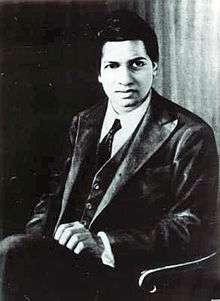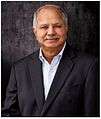University of Madras
| சென்னைப் பல்கலைக்கழகம் | |
|
Coat of arms of the University of Madras | |
| Motto | Doctrina Vim Promovet Insitam (Latin) |
|---|---|
Motto in English | "Learning Promotes Natural Talent" |
| Type | Public |
| Established | 1857 |
| Chancellor | Governor of Tamil Nadu |
| Vice-Chancellor | Vacant |
| Students | 4,819 |
| Undergraduates | 67 |
| Postgraduates | 3,239 |
| Location |
Chennai, Tamil Nadu, India 13°5′2″N 80°16′12″E / 13.08389°N 80.27000°ECoordinates: 13°5′2″N 80°16′12″E / 13.08389°N 80.27000°E |
| Campus | Urban |
| Colors | Cardinal |
| Nickname | Madras University |
| Mascot | Lion |
| Affiliations | UGC, NAAC, AIU |
| Website |
www |
 | |
The University of Madras (Tamil: சென்னைப் பல்கலைக்கழகம்; informally known as Madras University) is a public state university in Chennai (formerly Madras), Tamil Nadu.[1] Established in 1857, it is one of the oldest and premier universities in India. The university was incorporated by an act of the Legislative Council of India.[2]
It is a collegiate research university and has six campuses in the city viz., Chepauk, Marina, Guindy, Taramani, Maduravoyal and Chetpet. At present, there are 73 academic departments grouped under 18 schools, covering diverse areas such as sciences, social sciences, humanities, management and medicine along with 109 affiliated colleges and 52 approved research institutions.
The National Assessment and Accreditation Council has conferred 'five star' accreditation to the university and it has been given the status of 'University with Potential for Excellence' by the University Grants Commission.[3]
History
| Vice Chancellors[4] |
|---|
|



The first ever demand for higher education in Madras Presidency was given in a public address to Lord John Elphinstone, Governor of Madras, signed by 70,000 residents when the Governor in Council was contemplating "some effective and liberal measures for the establishment of an improved system of national education." This public petition, which was presented by the Advocate General Mr. George Norton on 11 November 1839, pressed the need for an English college in the city of Madras. Pursuant to this, Lord Elphinstone evolved a plan for the establishment of a central collegiate institution or a ‘university.’ This university had twin departments – a high school for the cultivation of English literature, regional language, philosophy and science, and a college for instruction in the higher branches of literature, philosophy and science.
The University Board was constituted in January 1840 with Mr. George Norton as its President. This was the precursor of the present Presidency College, Chennai. A systematic educational policy for India was formulated 14 years later by Wood's despatch, which pointed out the rationale for "creating a properly articulated system of education from the primary school to the University." The Dispatch recommended the establishment in the universities of Professorships "for the purposes of the delivery of lectures in various branches of learning including vernacular as well as classical languages." As a result, the University of Madras, organized on the model of the University of London, was incorporated on 5 September 1857 by an Act of the Legislative Council of India.
The university progressed and expanded through the 19th century to span the whole of South India, giving birth to universities like Mysore University (1916), Osmania University (1918), Andhra University (1926), Annamalai University (1929), Travancore University (1937) presently University of Kerala, Sri Venkateswara University (1954), Madurai Kamaraj University (1966), Bharathidasan University (1982), Bharathiar University (1982), Manonmaniam Sundaranar University (1990), Tamil Nadu Agricultural University (1971), Anna University (1978), Tamil University (1981), Mother Teresa Women's University (1984), Dr. M.G.R. Medical University (1989), Veterinary and Animal Sciences University (1989), Periyar University (1997) and Dr. Ambedkar Law University (1996).
In 1912 endowments were made to the university to establish departments of Indian History, Archaeology, Comparative Philology and Indian Economics. In that year the university had 17 departments, 30 teachers, and 69 research scholars. Later the research and teaching functions of the university were encouraged by the Sadler Commission and the gains of the University were consolidated by the enactment of the Madras University Act of 1923. About this time, the territorial ambit of the Madras University encompassed from Berhampur of Orissa in the North East, Trivandrum of Kerala in the South West, Bangalore and Mangalore of Karnataka in the West and Hyderabad of Andhra Pradesh in the North.
Between 1926 and 1939, the university published the comprehensive Tamil Lexicon dictionary, which is the first among the dictionaries published in any Indian language.[5]
Coat of arms
The description of the Coat of Arms of the university, designed in 1857, is:
"Argent (silver or white) on a Mount issuant from the basement a Tiger passant proper (walking and coloured naturally), on a Chief Sable (black across the top), a Pale Or (a gold or yellow vertical strip down the centre 1/3 of the top or chief), thereon, between two Elephants heads couped of the field, a lotus flower leaved and slipped of the third, together with this motto Doctrina Vim Promovet Insitam".
The coat of arms colours are: the base is light green, the tiger is yellow on a white background, the elephant is grey on a black background, the lotus is a white flower with olive green leaves, on a gold background. The motto scroll is edged red, with black lettering. The English translation of the motto of the University of Madras is: "Learning promotes natural talent."

Campuses
The university is spread over six campuses, viz., Chepauk, Marina, Guindy, Taramani, Chetput and Maduravoyal. The Chepauk campus of the university houses the VC's secretariat, central library, centenary auditorium and the historic Senate House. The oriental and Indian languages departments are located in the Marina Campus. The Guindy campus incorporates the natural sciences departments while the campus at Taramani houses the school of basic medical sciences. The sports union and the botanical garden are based in Chetpet and Maduravoyal campus respectively.
Senate House
The University of Madras has a historical monument – Senate House – which is one of the landmarks of the city of Chennai. The Senate House, the University's first building, inaugurated in the year 1879, is a masterpiece of Robert Fellowes Chisholm, an architect of the 19th century, who blended the Indo-Saracenic style with Byzantine and European architectural features. The university renovated the Senate House in 2006.
Affiliated colleges and research institutions
Notable colleges
- Loyola College
- Presidency College
- Madras Christian College
- Stella Maris College
- Women's Christian College
- Ethiraj College for Women
- Pachaiyappa's College
- Queen Mary's College
- The New College
- Madras School of Art
- Madras School of Social Work
- A. M. Jain College
- DG Vaishnav College
- Guru Nanak College
- M.O.P. Vaishnav College
- SHASUN College
- Stella Matutina College of Education
- Vivekananda College
Research institutions
- Adyar Cancer Institute
- Central Leather Research Institute
- Central Institute of Brackish Water Aquaculture
- Central Institute of Plastics Engineering and Technology
- Defence Services Staff College, Wellington
- Institute for Financial Management and Research
- King Institute of Preventive Medicine and Research
- Loyola Institute of Business Administration
- Madras Institute of Development Studies
- Madras School of Economics
- MS Swaminathan Research Foundation
- National Defence College, New Delhi
- National Institute for Research in Tuberculosis
- National Institute of Epidemiology
- Ramanujan Institute for Advanced Study in Mathematics
Notable alumni
University of Madras has a strong alumni network with its alumni taking over many prestigious positions across the world. Some of the prominent alumni include Nobel laureates C. V. Raman[6] and S. Chandrasekhar,[7] mathematicians Srinivasa Ramanujan and S. R. Srinivasa Varadhan, former presidents Sarvepalli Radhakrishnan, V. V. Giri, Neelam Sanjeeva Reddy, R. Venkataraman and A.P.J. Abdul Kalam, politicians Chakravarthi Rajagopalachari, C Subramaniam, CN Annadurai and V. K. Krishna Menon, civil servants T. N. Seshan, Benegal Rama Rau and Y. Venugopal Reddy, pioneers Verghese Kurien, Raj Reddy, Rangaswamy Srinivasan and M. S. Swaminathan, economist C. K. Prahalad, K. N. Raj, Raja Chelliah and C. Rangarajan, business persons Indra Nooyi, Ram Shriram and Prathap C. Reddy, cinema actors and directors M.G. Ramachandran, Gemini Ganesan and Mani Ratnam, sports stars Viswanathan Anand, Vijay Amritraj and Ramanathan Krishnan among others.
- Physics Nobel laureate, Sir C. V. Raman
 India's greatest mathematician, Srinivasa Ramanujan
India's greatest mathematician, Srinivasa Ramanujan 2nd President of India, Sarvepalli Radhakrishnan
2nd President of India, Sarvepalli Radhakrishnan 11th President of India, A.P.J. Abdul Kalam
11th President of India, A.P.J. Abdul Kalam- M. S. Swaminathan, Father of green revolution
 Computer scientist, Raj Reddy
Computer scientist, Raj Reddy PepsiCo Chairperson, Indra Nooyi
PepsiCo Chairperson, Indra Nooyi Chess Grandmaster, Viswanathan Anand
Chess Grandmaster, Viswanathan Anand- Cognitive neuroscientist, V. S. Ramachandran
Rankings
Madras University has been consistently listed among top ranked universities for its academics and research output.[8] Internationally, the university was ranked 70th in the QS University Rankings: BRICS 2013.[9] Ranked by the number of international students the university is placed 1st in India and 11th among BRICS nations.[10] In rankings of Indian universities, it was ranked 5th by the India Today top universities ranking of 2011.[11]
Grants
In 2011, the University Grants Commission selected the university as a university with potential for excellence, under which the university gets ₹ 250 million (₹ 25 crore). The university had been selected under phase 1 of the scheme in 2001–02 along with a few other universities in the country. UGC has identified the school of geology and the school of zoology of the university as centres of excellence and has allotted ₹ 32.5 million (₹ 3.25 crore) each for their development. The university is planning to use the funds to buy equipment and improve infrastructure.[12]
See also
References
- ↑ Indian Universities in the 2014 QS University Rankings: BRICS. Top Universities (24 June 2014). Retrieved on 2015-09-27.
- ↑ University of Madras. Encyclopaedia Britannica.
- ↑ University Grants commission ::Universities (UPE). Ugc.ac.in. Retrieved on 27 September 2015.
- ↑ "The Vice Chancellors". University of Madras. Retrieved 17 June 2013.
- ↑ Kolappan, B. (22 June 2014). "Delay, howlers in Tamil Lexicon embarrass scholars". The Hindu. Chennai: The Hindu. Retrieved 25 December 2014.
- ↑ "After earning a master’s degree in physics at Presidency College, University of Madras, in 1907, Raman became an accountant in the finance department of the Indian government." http://www.britannica.com/EBchecked/topic/490449/Sir-Chandrasekhara-Venkata-Raman
- ↑ "Chandra studied at Presidency College, University of Madras, and he wrote his first research paper", http://www-history.mcs.st-and.ac.uk/history/Biographies/Chandrasekhar.html
- ↑ Ranking and Performance of Indian Universities, Based on Publication and Citation Data | Gupta | Indian Journal of Science and Technology. Indjst.org. Retrieved on 27 September 2015.
- ↑ QS University Rankings: BRICS 2013. Top Universities. Retrieved on 27 September 2015.
- ↑ QS University Rankings: BRICS 2014. Top Universities. Retrieved on 27 September 2015.
- ↑ India's best universities: On higher ground : EDUCATION – India Today. Indiatoday.intoday.in. Retrieved on 27 September 2015.
- ↑ "UGC selects Madras univ as potential centre of excellence, grants Rs 25 cr". The Times of India epaper. Chennai: The Times Group. 29 December 2011. Retrieved 30 December 2011.
External links
| Wikimedia Commons has media related to University of Madras. |
